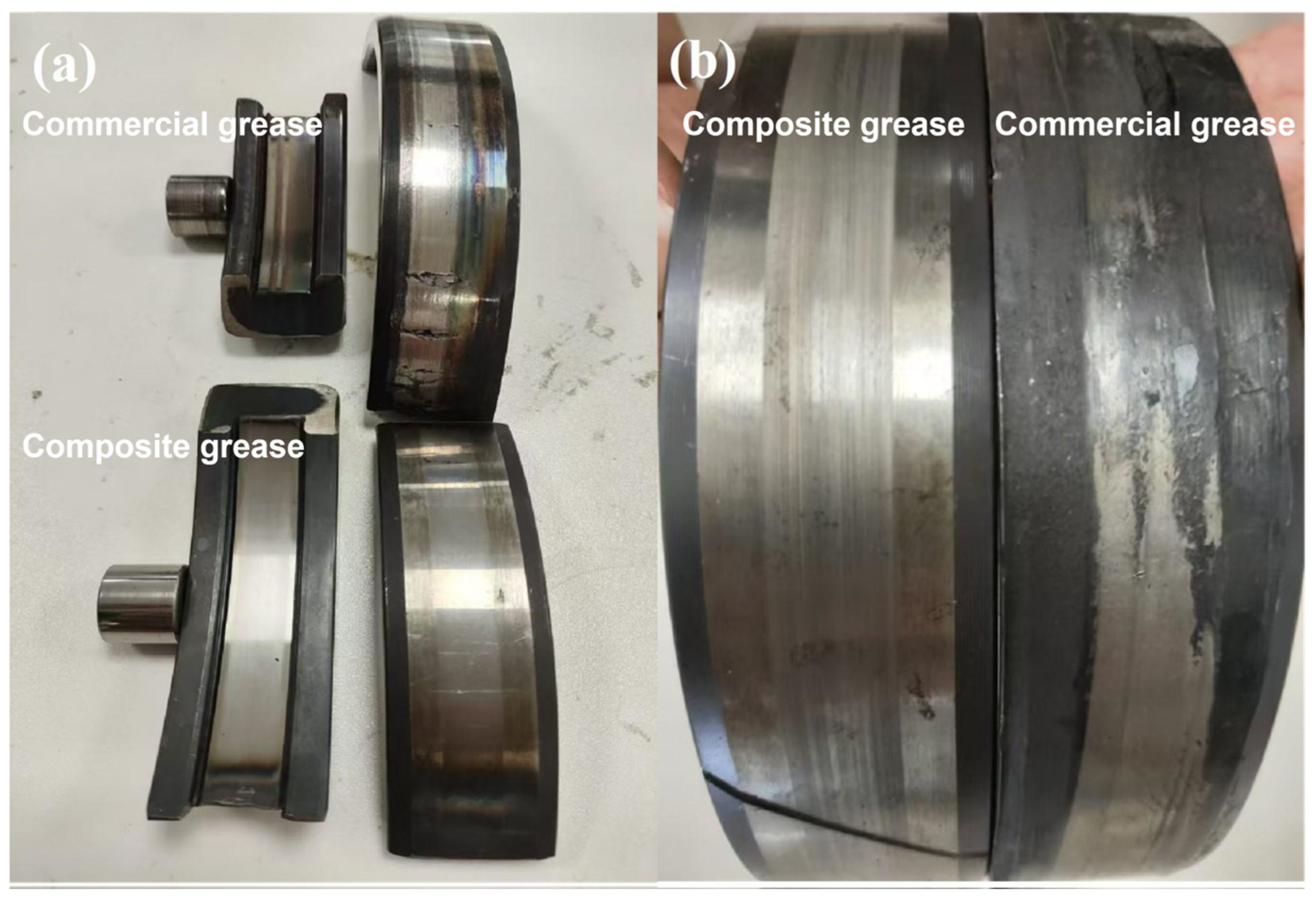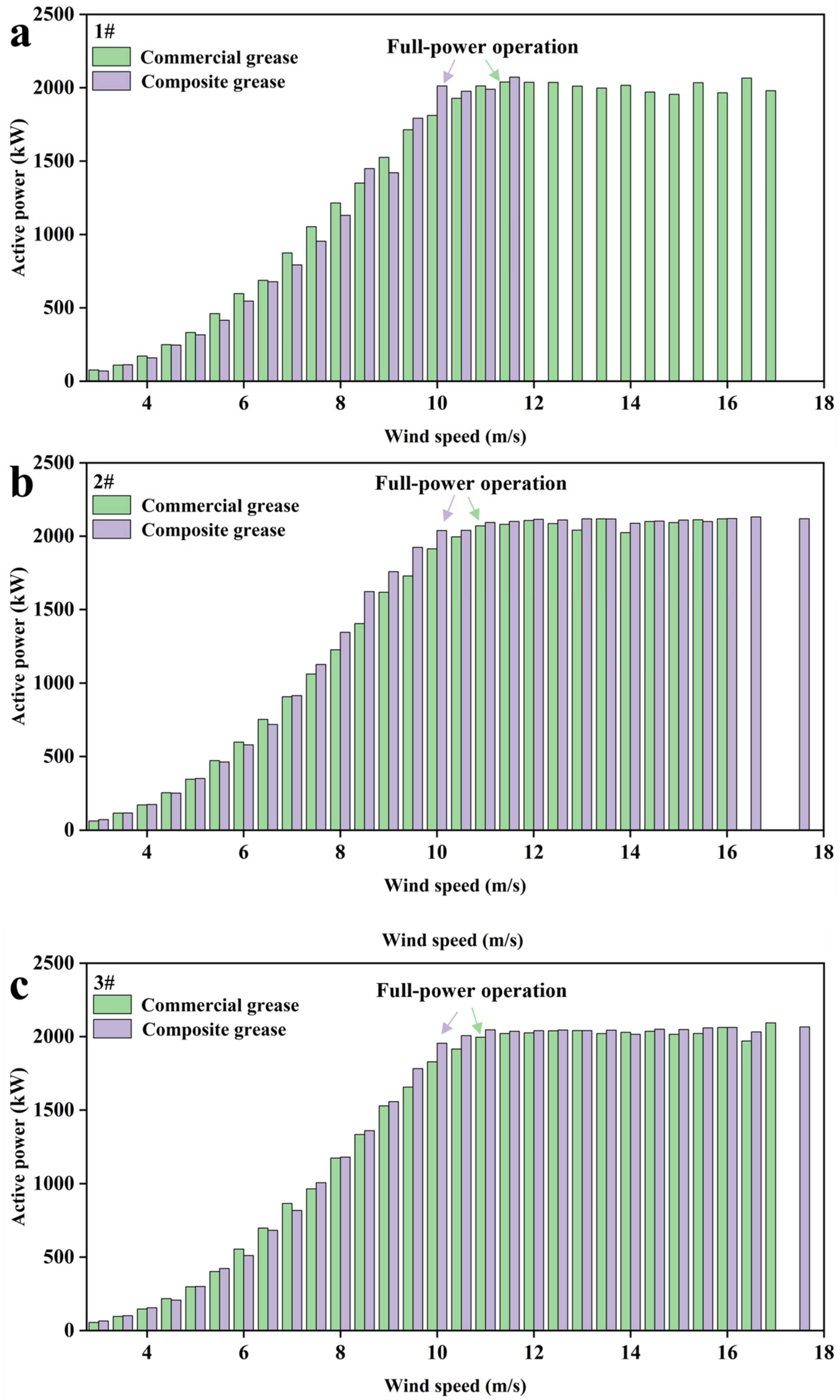Analysis of the Effect of Grease Containing Magnesium Hydroxysilicate in Wind Power Bearing Field Tests
Abstract
1. Introduction
2. Experimental Section
2.1. Compound Grease Formulation
2.2. Test Methods
3. Results and Discussion
3.1. Bearing Temperature Rise
3.2. Bearing Vibration
3.3. Worn Surfaces
3.4. Wind Turbine Power
4. Conclusions
Supplementary Materials
Author Contributions
Funding
Data Availability Statement
Acknowledgments
Conflicts of Interest
References
- Dhanola, A.; Garg, H.C. Tribological challenges and advancements in wind turbine bearings: A review. Eng. Fail. Anal. 2020, 118, 104885. [Google Scholar]
- Liu, Z.; Zhang, L. A review of failure modes, condition monitoring and fault diagnosis methods for large-scale wind turbine bearings. Measurement 2020, 149, 107002. [Google Scholar] [CrossRef]
- Peng, H.; Zhang, H.; Fan, Y.; Shangguan, L.; Yang, Y. A review of research on wind turbine bearings’ Failure analysis and fault diagnosis. Lubricants 2023, 11, 14. [Google Scholar] [CrossRef]
- Peng, H.; Zhang, H.; Shangguan, L.; Fan, Y. Review of tribological failure analysis and lubrication technology research of wind power bearings. Polymers 2022, 14, 3041. [Google Scholar] [CrossRef] [PubMed]
- Schwack, F.; Bader, N.; Leckner, J.; Demaille, C.; Poll, G. A study of grease lubricants under wind turbine pitch bearing conditions. Wear 2020, 454, 203335. [Google Scholar]
- Kaytez, F. Evaluation of priority strategies for the expansion of installed wind power capacity in Turkey using a fuzzy analytic network process analysis. Renew. Energy 2022, 196, 1281–1293. [Google Scholar] [CrossRef]
- Shi, G.; Yu, X.; Meng, H.; Zhao, F.; Wang, J.; Jiao, J.; Jiang, H. Effect of surface modification on friction characteristics of sliding bearings: A review. Tribol. Int. 2023, 177, 107937. [Google Scholar] [CrossRef]
- Liu, J.; Song, D.; Li, Q.; Yang, J.; Hu, Y.; Fang, F.; Joo, Y.H. Life cycle cost modelling and economic analysis of wind power: A state of art review. Energy Conv. Manag. 2023, 277, 116628. [Google Scholar] [CrossRef]
- Jin, Y.; Cai, X.; Zhang, P.; Zeng, D.; Tu, X.; Chen, D. Friction and self-repairing behaviour of magnesium silicate hydroxide-MoS2 lubricant additives on gray cast iron with Cr-coated steel ball friction pairs. Tribol. Int. 2024, 195, 109665. [Google Scholar] [CrossRef]
- Liu, H.; Xie, M.; Pan, B.; Li, N.; Zhang, J.; Lu, M.; Luo, J.; Wang, H. In-situ intercalated pyrolytic graphene/serpentine hybrid as an efficient lubricant additive in paraffin oil. Colloid Surf. A-Physicochem. Eng. Asp. 2022, 652, 129929. [Google Scholar]
- Wang, B.; Zhong, Z.; Qiu, H.; Chen, D.; Li, W.; Li, S.; Tu, X. Nano serpentine powders as lubricant additive: Tribological behaviors and self-repairing performance on worn surface. Nanomaterials 2020, 10, 922. [Google Scholar] [CrossRef]
- Wang, C.; Sun, J.; He, J.; Ge, C. Friction-induced motion evolution of reduced graphene oxide-Al2O3 at contact interface to achieve superior lubrication performance. Appl. Surf. Sci. 2022, 604, 154479. [Google Scholar] [CrossRef]
- Yin, Y.; Yu, H.; Wang, H.; Song, Z.; Zhang, Z.; Ji, X.; Cui, T.; Wei, M.; Zhang, W. Friction and wear behaviors of steel/ bronze tribopairs lubricated by oil with serpentine natural mineral additive. Wear 2020, 456, 203387. [Google Scholar] [CrossRef]
- Wu, J.; Wang, X.; Zhou, L.; Wei, X.; Wang, W. Formation factors of the surface layer generated from serpentine as lubricant additive and composite reinforcement. Tribol. Lett. 2017, 65, 93. [Google Scholar] [CrossRef]
- Wang, K.; Chang, Q.; Gao, K.; Wang, B.; Gao, R.; Yan, Q. Octadecyltrimethoxysilane modified freeze-drying magnesium silicate hydroxide towards high-performance wear-resistance: Synthesis, characterization, and tribological evaluation. Wear 2023, 534, 205153. [Google Scholar] [CrossRef]
- Xie, S.; Duan, C.; Gao, C.; Zhang, S.; Zhang, P. Research progress on the application of magnesium silicate hydroxide in the field of lubrication. Surf. Technol. 2023, 52, 249–259. [Google Scholar]
- Yin, Y.; Song, Z.; Yu, H.; Ji, X.; Wang, H.; Zhou, X.; Zhang, W. Effect of lubrication oil containing synthetic serpentine nanotubes on tribological behaviors of magnesium alloy. Chin. J. Nonferrous Met. 2023, 33, 4013–4026. [Google Scholar]
- Yin, Y.; Yu, H.; Wang, H.; Ji, X.; Song, Z.; Zhou, X.; Wei, M.; Shi, P.; Zhang, W.; Zhao, C. Tribological behaviors of AZ91D magnesium alloy under the lubrication of oil suspended synthetic magnesium silicate hydroxide nanotubes. J. Magnes. Alloy. 2024, 13, 379–397. [Google Scholar] [CrossRef]
- Jang, D.; Kim, K.; Kim, K.H.; Kang, S. Techno-economic analysis and Monte Carlo simulation for green hydrogen production using offshore wind power plant. Energy Conv. Manag. 2022, 263, 115695. [Google Scholar] [CrossRef]
- Xu, F.; Ding, N.; Li, N.; Liu, L.; Hou, N.; Xu, N.; Guo, W.; Tian, L.; Xu, H.; Wu, C.; et al. A review of bearing failure Modes, mechanisms and causes. Eng. Fail. Anal. 2023, 152, 107518. [Google Scholar]
- Singla, Y.K.; Maughan, M.R.; Arora, N.; Dwivedi, D.K. Enhancing the wear resistance of iron-based alloys: A comprehensive review of alloying element effects. J. Manuf. Process. 2024, 120, 135–160. [Google Scholar] [CrossRef]
- Zeng, D.; Qiao, S.; Chen, X.; Gong, Y.; Jiang, B.; Zhao, H.; Zhang, J.; Lu, L. Rolling contact fatigue and wear behavior of a vanadium microalloyed railway wheel steel under dry rolling/sliding condition. Int. J. Fatigue 2024, 182, 108207. [Google Scholar] [CrossRef]
- Wang, B.; Gao, K.; Wang, Y.; Chang, Q.; Yang, H. Synergistic dispersion, adsorption, and anti-wear effects of magnesium silicate hydroxide nanomaterials and carboxylic acid. Appl. Surf. Sci. 2024, 665, 160373. [Google Scholar] [CrossRef]







| Items | Parameters |
|---|---|
| NLGI consistency grade | 2–3 |
| Soap type | Polyurea-based |
| Color | Blue |
| Base oil type | Mineral oil |
| Kinematic viscosity at 40 °C, mm2/s | 96 |
| Kinematic viscosity at 100 °C, mm2/s | 10.5 |
| Worked penetration, 0.1 mm | 245–275 |
| Dropping point, °C | >240 |
| Test Point | Hardness (Gpa) | Modulus (Gpa) |
|---|---|---|
| 1 | 6.017 | 201.400 |
| 2 | 6.027 | 198.66 |
| 3 | 6.478 | 213.250 |
| Average value | 6.174 | 204.439 |
Disclaimer/Publisher’s Note: The statements, opinions and data contained in all publications are solely those of the individual author(s) and contributor(s) and not of MDPI and/or the editor(s). MDPI and/or the editor(s) disclaim responsibility for any injury to people or property resulting from any ideas, methods, instructions or products referred to in the content. |
© 2025 by the authors. Licensee MDPI, Basel, Switzerland. This article is an open access article distributed under the terms and conditions of the Creative Commons Attribution (CC BY) license (https://creativecommons.org/licenses/by/4.0/).
Share and Cite
Wang, P.; Yang, C.; Shi, B.; Zhang, H. Analysis of the Effect of Grease Containing Magnesium Hydroxysilicate in Wind Power Bearing Field Tests. Processes 2025, 13, 1385. https://doi.org/10.3390/pr13051385
Wang P, Yang C, Shi B, Zhang H. Analysis of the Effect of Grease Containing Magnesium Hydroxysilicate in Wind Power Bearing Field Tests. Processes. 2025; 13(5):1385. https://doi.org/10.3390/pr13051385
Chicago/Turabian StyleWang, Peng, Changxing Yang, Bowen Shi, and Huizhe Zhang. 2025. "Analysis of the Effect of Grease Containing Magnesium Hydroxysilicate in Wind Power Bearing Field Tests" Processes 13, no. 5: 1385. https://doi.org/10.3390/pr13051385
APA StyleWang, P., Yang, C., Shi, B., & Zhang, H. (2025). Analysis of the Effect of Grease Containing Magnesium Hydroxysilicate in Wind Power Bearing Field Tests. Processes, 13(5), 1385. https://doi.org/10.3390/pr13051385





